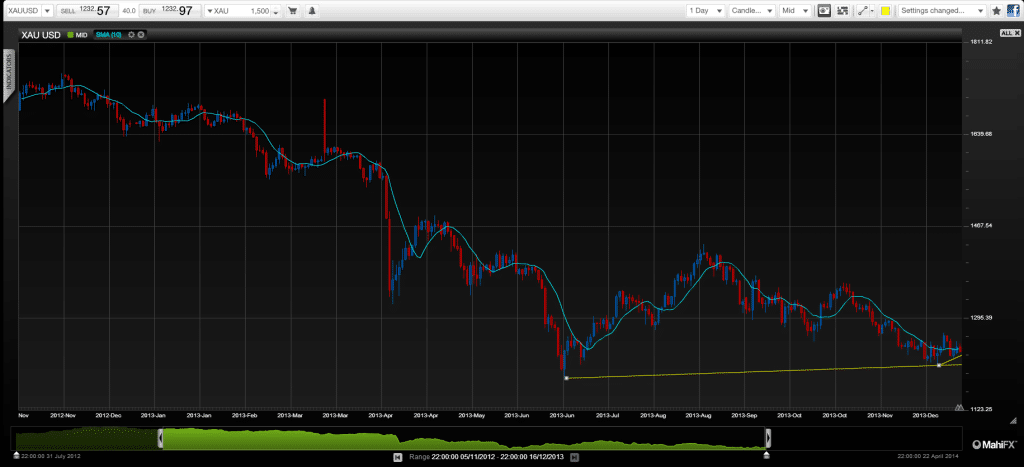Gold prices could bottom out next year with so much of the potential bad news for the yellow metal, such as rising economic confidence and the US Federal Reserve’s intentions to taper its bond purchasing programme already well known.
The outlook for gold for next year remains very uncertain. There are plenty traders betting that it will rack up further losses in 2014 and it is highly likely that there is still some more to come on the downside. Since peaking at $1,921 per troy OZ in July 2011 it’s been pretty much all downhill for gold, especially since August 2012. It is now hovering just above its 2013 low of $1,180 seen in June.
By Justin Pugsley, Markets Analyst MahiFX Follow MahiFX on twitter
When the Fed does announced its taper – it triggered some knee jerk selling of gold. It’s decade long bull run was very much fueled by easing monetary conditions. The prospect of it returning to ‘some sort of normal’ should be bad for gold. Another factor is the generally improving economic sentiment around the world driven by the US economic recovery. It lowers the need to hold risk insurance assets such as gold.
More downside still likely for gold
Below $1,000 would be heartbreak for many gold bugs
Gold is very likely to breach its 2013 lows of $1,180 per troy OZ. Support levels to watch out for are clustered around $1,196, $1,155 and $980. Fibonacci levels of $1,087 and $890 are key support levels, but are also potential targets for the bears. Certainly, anything below the psychologically important $1,000 level will lead to a great deal of despondency towards gold. Periods of maximum pessimism often represent the end of bear markets.
Summer tends to be important for gold in terms of turning points and if the $1,000 level is to be breached it could happen then. The Summer of 2014 could see the gold price bottom out or merely confirm that the current bear market has much further to run.
Gold’s bull market may well be over, but there are still some reasons why that may not be the case.
Unconventional monetary policy probably here to stay
Though the Fed’s taper is almost a forgone conclusion quantitative easing is by no means on the way out for good. The US recovery has required the most aggressive monetary stimulus of all time and even then it is hardly amongst the most impressive rebounds.
Given the deflationary bias in the world economy ultra low interest rates may now be part of a new normal. Once the US economy starts to lose steam or even slip back into recession quantitative easing will likely become one of the measures of first resort to rekindle growth.
Since 2008 the US monetary base has increased dramatically in size and the Eurozone’s has also increased substantially. This has been caused by unconventional monetary policies, which in turn undermine confidence in fiat currencies.
Heavily indebted Western governments, which are struggling to promote sustainable economic growth, also have a big incentive to ignite inflation to erode away their liabilities. It’s been practiced by governments of all political colours through out the ages.
Central banks funding government
However, inflation has been difficult to stimulate with real demand being so weak. In future the role of quantitative easing may simply be to help fund governments rather than stimulating growth especially if the inflation alternative is not there.
For instance, the UK’s stock of government bonds is already one third owned by the Bank of England. It pays the interest on those bonds back to the UK government. Therefore it is almost as if those bonds no longer exist and the central bank is effectively funding government expenditure.
Unless a formula is found for sustainable economic growth it is highly likely that unconventional monetary policies will continue to be used for years to come. Creating fiat money at a faster pace than gold can be mined should favour prices for the latter.
Analysis: Sweet Dectaper is still a taper – USD has the upper hand

